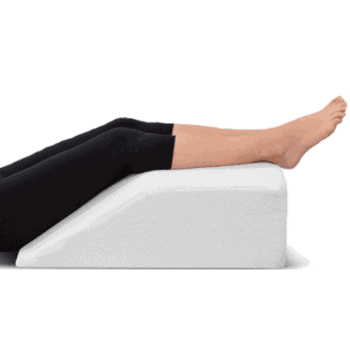Have you ever wondered why putting your feet up feels so darned good, especially after a hard day’s work? It’s down to basic science – your body’s circulatory system doesn’t have to fight gravity to ensure good blood flow. If taking pressure off your feet is so good, can you (in theory) sleep with your legs up too? What are some of the pros and cons of sleeping with legs elevated?
Sleeping With Your Feet Up
So how exactly do people sleep with their legs elevated? Let’s get down to the mechanics. It’s essentially the fetal position, but instead of being curled up on your side, you’re lying on your back. Your legs need to be at least a few inches higher than your body to achieve the desired effect. Some people even find it comfortable to cross their legs.
Topics Explored
- Why Do We Sleep with Legs Elevated? »
- Pros and Cons of Sleeping with Legs Elevated »
- How Should You Sleep with Elevated Legs? »
- Bottomline »
- FAQs »
Why Do We Sleep with Legs Elevated?
We are inclined to put our feet up (in front of the tv) after a long day. But some people do it while they are asleep and sometimes through the night. What are some of the reasons why we sleep with our legs elevated?
Pros and Cons of Sleeping with Legs Elevated
When looking at the pros and cons of sleeping with legs elevated, the benefits outnumber the negatives. By raising your legs, your heart gets the much-needed rest from pumping blood against gravity, and your extremities get relief from swelling and tension.
Pros of Sleeping with Legs Elevated:

Back Pain Relief
Sleeping with elevated legs can help tackle severe and chronic back pain(1) even when the cause is sciatica or a herniated disc. When counter-rotating the pelvis, you relieve your lower spine from the painful pressure. Depending on the severeness of your back pain, you might need a higher elevation or a pillow under the knees.
Reduces Swelling in the Legs
Spending your day on your legs is known to cause swelling. Blood is pulled into your veins more, and some of the water contained in the blood can enter your muscle tissue, causing swelling. By elevating your legs during the night, gravity pulls the water back and reduces swelling in your feet too(2).
Better Blood Circulation
Elevating your legs helps blood from your lower body travel quickly to your heart for re-oxygenation(3). Gravity does most of the work, and less pressure is exerted on the heart to get the blood circulated. Even the slightest leg elevation helps the filtering and re-circulation process, puts less strain on your heart, and improves cardiovascular function.
Prevent & Treat Varicose Veins
Spending most of our day standing means you’re prone to swelling and the appearance of varicose or spider veins. While they’re not a threat to your well-being, they’re far from a pleasant sight. Varicose veins are enlarged, curved veins most commonly developing in your lower legs. Doctors recommend elevating your legs overnight as the best way to tackle them(4).
Faster Recovery
Elevating an injured leg is the first piece of advice you’ll get from your doctor. The reason behind it is the reduction of swelling(5). Swelling can put additional pressure and pain on the injury site. To prevent it, elevate your injury above the level of your heart. It will help drain the excess fluid, reduce the pain, and speed up the healing process.
Cons of Sleeping with Legs Elevated:

Leg Numbness
Sleeping with your legs up should be introduced gradually to see at what height you’re comfortable. If the elevation is too high, you might end up with numbness in your legs during sleep and when you wake up. The reason lies in the low blood flow to your lower extremities.
Discomfort
Getting adjusted to sleeping with elevated legs can be specifically hard if your favorite sleeping position is on your side or stomach. It’s a significant change even for back sleepers. It takes some time to adjust so that you can experience discomfort at the beginning. Not to forget, the constant contact of your skin with the elevation aid can lead to irritation.
How Should You Sleep with Elevated Legs?
After weighing the pros and cons of sleeping with legs elevated, let’s figure out how you can adopt the correct position. You need to elevate your legs above the heart level, and the angle between your thighs and the bed shouldn’t be greater than 45 degrees. Raise your lower legs too, and slightly bend your knees to avoid putting strain on your muscles and tendons. Sometimes, the use of props can help too.
Use a Leg Elevation Pillow

A leg elevation pillow is your best bet for keeping your legs elevated all night. Regular pillows won’t work as well. You’ll need a stack to achieve the correct height above the heart level, and they’ll shift with every move.
The leg pillows that resemble a wedge can be found in the right size and provide a steady incline which helps you prevent additional muscle strain.
Use an Adjustable Bed
Pillows are not a long-term solution, especially if you tend to shift and move throughout the night. Once you’ve adapted to sleeping with your legs elevated, you can consider investing in an adjustable bed.
You can adjust the elevation until it’s just right and program it to remember that exact setting. You don’t have to worry about your pillow shifting in your sleep and waking up to re-adjust it.

Final Thoughts on the Pros and Cons of Sleeping with Legs Elevated
After tackling all the pros and cons of sleeping with legs elevated, it’s safe to say that the benefits are definitely in the lead. The active way of life has us standing most of the time we’re awake, so why not help our legs and heart rest better at night? But there’s still caution to be had, and it’s good to discuss this way of sleeping with your doctor.
FAQs:
Can you elevate your leg too much?
It’s possible to have to elevate your legs way too much, and you’ll feel the consequences right away. You can wake up sore and with unpleasant numbness in your legs. The angle between your legs and the sleep surface should not be greater than 45 degrees; otherwise, you’re risking adverse outcomes.
Is it safe to sleep propped up while pregnant?
During the first trimester, a pregnant woman can sleep in any position. As the pregnancy advances and back pain is experienced, sleeping on the left side with a pillow between the legs provides the best relief. Swollen legs and feet are typical in the last trimester. Leg elevation is recommended to ease the pain.
Does sleeping with legs elevated help back pain?
Those suffering from back pain are often advised to sleep on their back and use a small pillow under their knees. Elevating your legs can help with easing your chronic back pain significantly more than just sleeping on your back. Lifting your legs takes the pressure off your lower spine and relieves the pain.
Verified Sources:
- Mayo Clinic: https://www.mayoclinic.org/diseases-conditions/back-pain/multimedia/sleeping-positions
- NYU Langone Health: https://nyulangone.org/conditions/lymphedema-in-adults/treatments/lifestyle-changes-for-lymphedema
- Rochester Medical Center: https://www.urmc.rochester.edu/encyclopedia/
- Michigan Medicine: https://www.uofmhealth.org/health-library
- Rehab Access: https://rehabaccess.com/why-does-elevating-a-sports-injury-help-it-heal